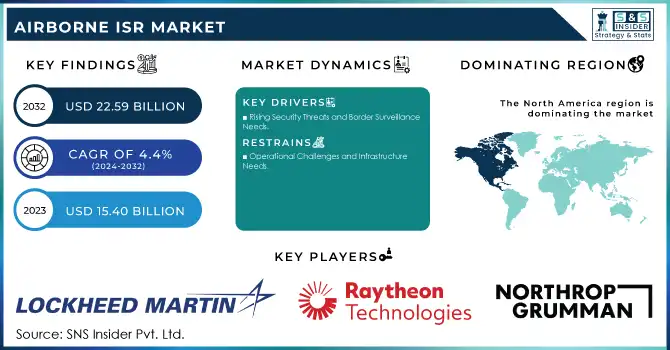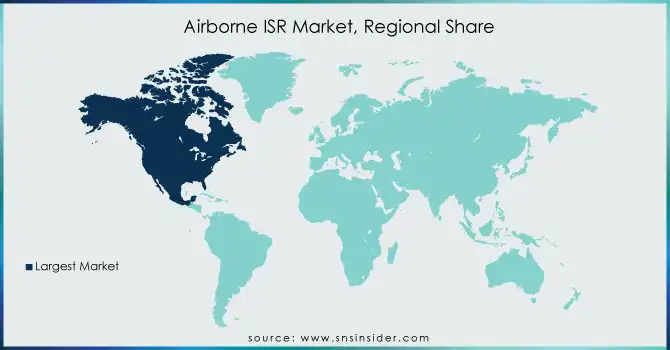Airborne ISR Market Report Scope & Overview:
The Airborne ISR Market size was USD 15.40 billion in 2023 and is expected to reach USD 22.59 billion by 2032, growing at a CAGR of 4.4% over the forecast period of 2024–2032.
Recalling the uncertainty of COVID-19, we continue to monitor and evaluate the direct and indirect impact of the epidemic. This information is included in the report as a major part of the market.Air intelligence, surveillance and ISR systems help detect and track friendly and hostile forces as well as detect damage to hostile targets in your area of interest.
They also assist in carrying out various security activities to raise awareness of the security situation of the military. These systems use three different types of electrical sensors to capture information that includes electrolyte-optical / infrared (EO / IR) sensors, radar, and signal-sensing systems (SIGINT). Today, security officials are spending money on ISR programs operating in the air to improve national security and to obtain data from potential enemies.

To get more information on Airborne ISR Market - Request Free Sample Report
Market Dynamics
Drivers
Inhumane systems have become an integral part of the military world. Sending ISR systems over the air to empty spaces facilitates the transfer of surveillance data and photos. The integration of virtual systems with communication poles and other security devices aids in a variety of important tasks. In addition, unmanned aircraft not only require personnel but thus reduce the risk of losing human life. As a result of these benefits, countries such as the US, India, and China have allocated large budgets to acquire and deploy additional UAVs in their defense forces, particularly ISR applications. The increase in the deployment of UAV aircraft surveillance and mapping systems is causing a growing need for small, integrated ISR systems that can be successfully integrated within the UAV platform without disrupting all of its operations. Therefore, a few of the major industry players in the ISR market, including Leonardo S.p.A (Italy) and Lockheed Martin (US), are emphasizing the development and delivery of lightweight ISR systems for the UAV platform.
Restraints
The low-accuracy features of Airborne ISR technology limit their performance and performance to systems that require the most accurate information. In addition, their maintenance and integration require highly skilled personnel and a controlled environment to eliminate any pollution. These structures in the integration and maintenance of the Airborne ISR serve as a barrier to the growth of the Airborne ISR market globally. The current network of military bases in various countries around the world does not seem to be able to transfer such high amounts of data in real-time. Highly advanced infrastructure is needed to facilitate the transfer of effective real-time information and data analysis. Such infrastructure requires large investments; this will greatly limit the growth of the Airborne ISRI market. The low accuracy features of Airborne ISR technology limit their performance and performance in systems that require the most accurate information. In addition, their maintenance and integration require highly skilled personnel and a controlled environment to eliminate any pollution. These structures in the integration and maintenance of the Airborne ISR serve as a barrier to the growth of the Airborne ISR market globally. The current network of military bases in various countries around the world does not seem to be able to transfer such high amounts of data in real-time. Highly advanced infrastructure is needed to facilitate the transfer of effective real-time information and data analysis. Such infrastructure requires large investments; this will greatly limit Airborne ISR market growth
OPPORTUNITIES
Improved system reliability is an important factor in the selection of ISR aircraft equipment in any country. The installation of advanced computer units helps to collect and distribute images at various defense platforms such as combat vehicles and command headquarters. Both commercial and aerospace surveillance systems have evolved over time and are evolving, such as the use of software-defined radio and open-source radios. These surveillance radars have been used in strategic areas to increase acquisition rates. Modern electronic surveillance systems with low alarms have led countries with border disputes, drug trafficking problems, and illegal immigrants to rely on these advanced ISR systems to help with border protection. Therefore, the rise of research and development activities in advanced ISR technologies and their implementation to date provides a wide range of opportunities for defense sector applications.
CHALLENGES
Due to the increasing demand for more accurate information, the use of sophisticated ISR technology is also growing in the aerospace and defense sector. ISR military equipment is integrated into various aircraft control systems to perform different functions. The complexity of the designs of these systems is constantly evolving, due to the increasing number of tasks they have to perform to meet the needs of end-users. This has led to the manufacturers of ISR systems focusing on adding new functionality to the designs of these systems. Therefore, sophisticated growth in projects is expected to make their production process more expensive as manufacturers need to incorporate sophisticated equipment to produce ISR aircraft systems.
Some of the factors that increase the increasing demand for various ISR strategies and tools and the growing adoption of ISR technology to protect their borders are expected to stimulate demand during the forecast period. However, the high costs associated with aviation intelligence monitoring and restructuring are expected to hamper the market growth. In addition, the increase in integration of devices based on Android and iOS has already emerged as profitable market opportunity during the forecast period. The ISR market trends on the air are as follows
The Impact of Covid-19 on the Market
The COVID-19 crisis will affect for years, and the aviation market will take years, perhaps a decade, to return to pre-disaster levels.
The airborne transmission of COVID-19 is contagious, the detection of this airborne virus is not related to infection, and the effectiveness of airborne pathogens is crucial to understanding aerosol transmission.
COVID-19 has successfully shaped the aviation industry and forced leaders to reconsider and change many uncertainties such as fuel prices, overcrowding, reliability, and aviation regulations, legacy technology Eco-system, and more.
The aviation industry that makes the world a small place is feared to accelerate the impact of the epidemic as travel is replaced by visible communication and can become a habit, at least for some time.
The components and equipment needed to build the aerial ISR were not available for production.
The supply chain faces transportation-related delays due to traffic restrictions and staff shortages.
Production/integration lines are also operated at low prices or completely closed.
The operators of the long-term ISR aviation market remained strong, and, prior to the epidemic, the market had begun to show signs of recovery in the re-capitalization of the capital market. The COVID-19 epidemic has swept across the globe, with many industries struggling to keep up. Governments and businesses involved with the ISR react differently to this new situation. Some product launches are moving forward, and some are not moving; some trials are ongoing, and some are delayed; some companies are still operating, while others are closed.The spread of the COVID-19 epidemic has led to disruption of procurement and operational disruption throughout North America.
KEY MARKET SEGMENTS
By Solution
-
Systems
-
Software
-
Service
By Platform
-
Military Aircraft
-
Military Helicopters
-
Unmanned Systems
By Application
-
Search and Rescue Operations
-
Border and Maritime Patrol
-
Target Acquisition and Tracking
-
Critical Infrastructure Protection
-
Tactical Support
-
Others
By End User
-
Defense
Regional Analysis
North America
-
USA
-
Canada
-
Mexico
Europe
-
Germany
-
UK
-
France
-
Italy
-
Spain
-
The Netherlands
-
Rest of Europe
Asia-Pacific
-
Japan
-
South Korea
-
China
-
India
-
Australia
-
Rest of Asia-Pacific
The Middle East & Africa
-
Israel
-
UAE
-
South Africa
-
Rest of Middle East & Africa
Latin America
-
Brazil
-
Argentina
-
Rest of Latin America

Need any customization research on Airborne ISR Market - Enquiry Now
Key Players
The Key Players are Lockheed Martin Corporation, Raytheon Company, Northrop Grumman Corporation, UTC Aerospace Systems, The Boeing Co., Rockwell Collins Inc., Thales S.A, BAE Systems plc, L-3 Technologies Inc., General Dynamics Corporation & Other Players.
| Report Attributes | Details |
|---|---|
| Market Size in 2023 | US$ 15.40 Billion |
| Market Size by 2032 | US$ 22.59 Billion |
| CAGR | CAGR of 4.4% From 2024 to 2032 |
| Base Year | 2023 |
| Forecast Period | 2024-2032 |
| Historical Data | 2020-2022 |
| Report Scope & Coverage | Market Size, Segments Analysis, Competitive Landscape, Regional Analysis, DROC & SWOT Analysis, Forecast Outlook |
| Key Segments | • By Solution (Systems, Software, Service) • By Platform (Military Aircraft, Military Helicopters, Unmanned Systems) • By Application (Search and Rescue Operations, Border and Maritime Patrol, Target Acquisition and Tracking, Critical Infrastructure Protection, Tactical Support) • By End User (Defense, Homeland Security) |
| Regional Analysis/Coverage | North America (USA, Canada, Mexico), Europe (Germany, UK, France, Italy, Spain, Netherlands, Rest of Europe), Asia-Pacific (Japan, South Korea, China, India, Australia, Rest of Asia-Pacific), The Middle East & Africa (Israel, UAE, South Africa, Rest of Middle East & Africa), Latin America (Brazil, Argentina, Rest of Latin America) |
| Company Profiles | Lockheed Martin Corporation, Raytheon Company, Northrop Grumman Corporation, UTC Aerospace Systems, The Boeing Co., Rockwell Collins Inc., Thales S.A, BAE Systems plc, L-3 Technologies Inc., General Dynamics Corporation. |
| Key Drivers | • Inhumane systems have become an integral part of the military world. |
| RESTRAINTS | • The low-accuracy features of Airborne ISR technology limit their performance and performance to systems that require the most accurate information. |

